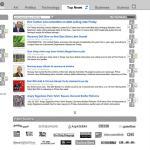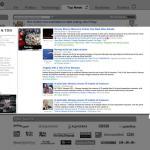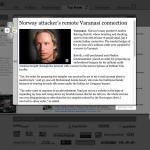The 2 Minute Pitch
The Problem
Newsle addresses the problem that people aren’t very curious about what’s going on in the world. They’re curious about what’s going on in their world and how something affects them. The solution is a web-based platform that allows the organization and categorization of news to be crowd sourced and social.
The Solution
Imagine a platform that allows you to make associations between trends, stories, data, people and places, and see how other people have associated the same elements. Now imagine that you can see how the global community is organizing and categorizing a trend or story as well as how people you know are relating to that same trend or story. Imagine knowing and understanding why someone is sharing a story, what it means to them, how it affects them and who else is affected. Imagine knowing if you are affected. Imagine knowing what your friends and family are concerned with. Suddenly, the news isn’t just about what’s going on in the world, it’s about what’s going on in your world.
An Example
Here’s an example: Today’s top story is about a pregnant hamster that drowned in Paris Hilton’s pool. Another story about Syria threatening to expel a US Ambassador after he visited protestors is down on the list. A user who wishes to call attention to the Syria story, could do so by recommending that story and not recommending the hamster story. That user could also tie the story to other political positions of Middle Eastern states or data visualizations of similar political expulsions to the article. With the plethora of new information on the Syrian story, plus the fact that it’s been recommended by the user, the user’s friends and follower’s attention will be pulled away from the pregnant hamster.
The Details
Newsle allows the user to find, personalize, organize and socialize their news. It also allows for the crowd sourcing of tagging activities for semantic content analysis. Newsle will allow journalists to collect public opinion and research on any topic, and general users can participate in shaping the conversation. Users can form groups to collectively curate and organize news sources and stories for their organization or group.
The application will be built as an open source, browser based application that relies heavily on existing APIs and technologies, and it will use HTML5 and web standards.
This is a platform that displays trending topics and stories pulled from twitter and news aggregation APIs or RSS feeds. A user can add any RSS feed and group different feeds together. A user is given the ability to link trends, stories, data, people, and places together through the use of tagging. Those tags are shared globally, allowing users to see how other users have categorized and organized trends and stories. A trend is an intersection of all the stories that are similarly tagged. Because it’s volatile from an API perspective, the trend will automatically be tagged in relation to individual story tags.
The user sees a distinction between the global community’s relationships to trends and stories and their personal community of people interested in those trends or topics. A user can see what his friends or followers care about in relation to what the user cares about.
Followers and people to be followed are imported from Facebook, Twitter, Google+ or email. Users can be anonymous and follow other users who’s interests interest them. Actions taken are displayed via a status update. The user does not free form words as status, they choose a story or trend they want to comment on. Choosing a trend or story allows the user to comment on that thing. There’s also automatic status updates for actions you take. All status updates are linked to a trend, story or action taken.
A user can recommend or not recommend trends, link trends to stories and recommend or not recommend stories within the trends. They can also add trends or individual stories to their individual dashboards, and move stories around within their personal space.
The dashboard serves as a storage facility for news stories and trends that are particularly relevant to the user. These are stories that the user wants to be able to find again, to reference, to share or to keep track of developments on. This serves as a reading queue and an exposé. Shared bins allow multiple users to work together. This feature is in place for collaborative collection and association. The user also has the ability to set geolocative information to stories. Viewing another users bin will give context to what that user is interested in.
The platform has a data center that shows related data. Users can link stories to data and vice versa. A story info panel will show what people have linked the story too (trends, other stories), tags that have been assigned, related data visualizations and geo locative information. A trend info panel will show that information for the trend.
The Business of it
The main problem that Newsle seeks to address is the lack of news that is personal. The benefit of this from an organizational perspective is that aggregating everyone’s socially shared views of the news will allow us to tell not just the story of what’s happening, but how it’s being perceived.
Because the software uses existing APIs and gives users the ability to tag and rate in an independent platform, the competition is really just news aggregation applications.
If this software can implement feeds from the widest variety of external sources and give the user the mechanism to rate stories and trends within those sources, we will be able to see what is important not only globally, but to an individual as well as to an individual’s group.
Human beings want to feel connected, Newsle allows people to connect through what they feel is important.



